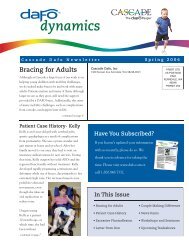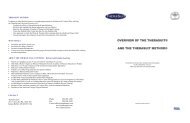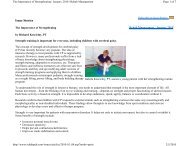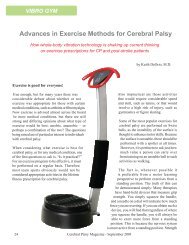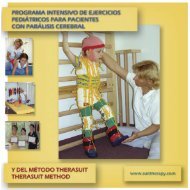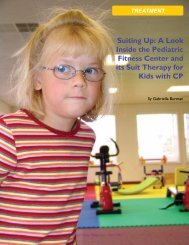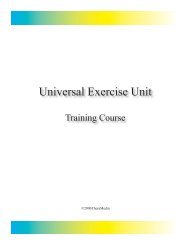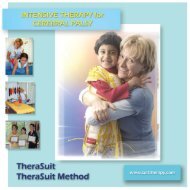Download - TheraSuit Method Intensive Suit Therapy for Cerebral ...
Download - TheraSuit Method Intensive Suit Therapy for Cerebral ...
Download - TheraSuit Method Intensive Suit Therapy for Cerebral ...
Create successful ePaper yourself
Turn your PDF publications into a flip-book with our unique Google optimized e-Paper software.
PHYSIOLOGY OF EXERCISES<br />
STRENGTH TRAINING AND CP<br />
Richard Koscielny<br />
“All human movement, from the blinking of an eye to the running of a marathon,<br />
depends on the proper functioning of skeletal muscle and its strength.”(5)<br />
Why do we need strength?<br />
Does a person with CP need strength training?<br />
These are some of the questions that we ask ourselves as<br />
parents and therapists. The answer to the first question is<br />
simple. Without strength we are unable to live. Each movement<br />
of our body depends on muscle strength. Without strength we<br />
are unable to eat, talk, walk, move and breathe. Strength of<br />
the muscle is essential to per<strong>for</strong>m daily activities and learn<br />
new functions. We can survive without endurance, speed, and<br />
flexibility, but we cannot without strength. Very often we <strong>for</strong>get<br />
about its importance.<br />
Is strength training important <strong>for</strong> CP?<br />
Muscle strength is even more crucial <strong>for</strong> individuals with a<br />
disability than <strong>for</strong> those without. It has been confirmed by<br />
studies and clinical experience.<br />
Many times to help our children we try new methods of therapy<br />
involving sophisticated technology, medication and surgeries.<br />
We are able to use surgical procedures to decrease mm tone<br />
and improve alignment of the bones. It is great, but very often<br />
not enough to learn a new function (walk, roll, sit). To learn<br />
those skills, we need to develop strength to control the muscles<br />
and the body.<br />
“Previously children with CP were not encouraged<br />
to strength train because it was felt this would<br />
increase spasticity and reduce flexibility, which<br />
would lead to the worsening of de<strong>for</strong>mities and<br />
walking problems.”(1)<br />
1. Misconceptions of strengthening programs<br />
Many specialists still believe that strength training is not<br />
appropriate in individuals with cerebral palsy because:<br />
- weakness is not a significant functional problem <strong>for</strong> them<br />
- an increase in strength will not improve function........<br />
- most of them cannot control their muscles sufficiently to<br />
train them.......................................................................<br />
- increased strength will increase spasticity..............<br />
- strengthening programs result only in hypertrophy of the<br />
muscles, and it does not effect the nervous system<br />
Another misconception involves the confusion about the<br />
difference between weight (strength) training and weight<br />
lifting.<br />
2. Facts .............................<br />
Dispelling these beliefs, many recent studies have<br />
demonstrated that:....... ......................................<br />
1. even mildly affected persons with CP have significantly<br />
reduced muscle strength, with the degree of weakness<br />
even greater in those with greater neurological<br />
involvement. In fact, weakness appears to have a<br />
stronger relationship with the level of motor functioning<br />
than other common symptoms such as spasticity or<br />
muscle tightness.<br />
2. individuals with CP can increase strength and improve<br />
passive motion through weight training.<br />
In this article I will present existing misconceptions about<br />
strength training. I will describe very important facts about<br />
the development of strength in young individuals, and explain<br />
the success of intensive therapy programs.<br />
12 <strong>Cerebral</strong> Palsy Magazine March 2004<br />
3. individuals with CP can increase strength in most if not<br />
all muscles at the same rate as persons without a brain<br />
lesion. Most importantly, strength training programs<br />
can produce positive changes in walking ability and in<br />
the per<strong>for</strong>mance of other motor tasks. There is
PHYSIOLOGY OF EXERCISES<br />
evidence of a relationship between lower limb strength<br />
values and motor abilities. An increase in strength of<br />
one muscle group does not change the outcome of<br />
function, but improvement in strength of more muscle<br />
groups will result in significant improvement of functional<br />
skills.<br />
4. no evidence exists to support the claim that strengthening<br />
exercises will increase spasticity. Strength training is<br />
perhaps most effective when per<strong>for</strong>med in conjunction<br />
with other types of activities, exercises, or therapeutic<br />
interventions. In 1956, Massey and Chaudet<br />
demonstrated that heavy resistance training does not<br />
cause a decrease in flexibility. Spasticity has not been<br />
found to increase with strength training in the research<br />
done by Damiano, Mac Phail and Holland.<br />
5. weight (strength) training <strong>for</strong> children is based basically<br />
on resistive exercises using thier own body weight<br />
instead of lifting heavy weights. Our children are<br />
constantly doing resistive (strengthening) exercises<br />
using the weight provided from the child’s own body.<br />
When a youngster does a push up, he lifts 60% of his<br />
body weight. If the child weights 50 pounds, he will<br />
lift 30 pounds per<strong>for</strong>ming push ups. Weightlifting, on<br />
F the other hand, is a competition where participants lift<br />
as much weight as they can at one time.<br />
3. Strength development<br />
For many years , strength gains were assumed to result directly<br />
from increases in muscle size (hypertrophy). Current research<br />
(Meredit, Frontera) proved that prepubescent strength gains<br />
are accomplished largely without any changes in muscle size.<br />
Young individuals develop strength through:<br />
- improved motor skills coordination<br />
- increased motor unit activation<br />
- and other neurological adaptations<br />
“During the first several weeks of resistive training, gains in<br />
strength are almost exclusively neural in nature, meaning the<br />
body is learning to recruit the correct muscles in the proper<br />
sequence while inhibiting unnecessary muscle recruitments.<br />
The physiologic changes, such as an increase in contractile<br />
proteins, stored nutrients, and anaerobic enzymes, take several<br />
weeks to develop. Once the neurologist “learning” phase<br />
begins to diminish, remodeling of the muscle is beginning to<br />
take place and strength gains continue.” (LeMura)<br />
Facts about CP and strength<br />
- Generally individuals with CP are weak<br />
- Spasticity is not related to mm strength<br />
- Strength in CP is directly related to function<br />
- Strengthening does not increase spasticity<br />
- The energy cost of walking in children with CP<br />
can be up to three times greater than children<br />
without CP<br />
- Children with CP complain of fatigue at a very<br />
low exercise intensity<br />
- Excessive coactivation within and between body<br />
segments could be responsible <strong>for</strong> the high<br />
energy cost of walking in children with CP<br />
Dynamic interplay of neural and hypertrophic factors<br />
<strong>for</strong> increased strength (5)<br />
During the first 2-4 weeks strength gains can be achieved<br />
without structural changes in the muscle, but not without neural<br />
adaptation. There are more neuro-functional adaptive changes<br />
than structural changes within the muscle. Thus, strength is<br />
not solely a property of the muscle rather it is the property of<br />
the motor system.<br />
Also, during the first weeks of strengthening exercises there<br />
is a reduction in the coactivation of other muscles (muscle<br />
synergies, pathological movements). It results in a decrease in<br />
energy expenditure, movement control improvement, and at<br />
the same time it leads to a decrease in mm spasticity (functional)<br />
resulting in functional improvement (or a great condition to<br />
achieve functional improvement). Continued on page 14<br />
<strong>Cerebral</strong> Palsy Magazine March 2004 13
PHYSIOLOGY OF EXERCISES<br />
After 4 weeks of resistive training, gains in strength are<br />
gradually achieved by increased size of the muscles<br />
(hypertrophy). The initial neural contribution to increase strength<br />
diminishes. At this time we will not notice further dramatic<br />
changes to the neuro-motor system of the body. Changes will<br />
be more specific and related only to the musculo-skeletal<br />
system.<br />
4. <strong>Intensive</strong> Exercise <strong>Method</strong>s<br />
Resistive training can induce adaptive alternations in nervous<br />
system function, along with changes in the morphology and<br />
architecture of the trained muscles. Resistance training that<br />
results in both improved neural function and gains in muscle<br />
mass will benefit not only athletes, but also aged individuals<br />
and individuals with neuro-motor disorders. This will provide<br />
an effective way to improve everyday physical function.<br />
These findings help us to explain the success of the new and<br />
popular intensive treatment programs <strong>for</strong> <strong>Cerebral</strong> Palsy (e.g.<br />
<strong>Suit</strong> <strong>Therapy</strong>).Very characteristic of these methods is the short<br />
time of duration (2-4 weeks) and high intensity of the exercises<br />
(volume, frequency, resistance).<br />
During 2-4 weeks of intensive therapy sessions, young<br />
individuals with CP per<strong>for</strong>m resistive exercises 3-4 hours per<br />
day, 5-6 days per week. Very often after this short period of<br />
treatment, these individuals present significant functional<br />
improvement. Based on the theory of strength development,<br />
the functional improvement occurring after a short period of<br />
strength training is related to motorneurological changes. In a<br />
short time individuals with CP improve movement control,<br />
balance and coordination. Often they are able to per<strong>for</strong>m<br />
functional skills that they were not able to do be<strong>for</strong>e (sit, roll, walk).<br />
This improvement is caused by adaptive changes that occur in<br />
the nervous system in response to strength training.<br />
Electromyogram studies have indicated other adaptation<br />
mechanisms that may contribute to an increased efferent<br />
neuronal outflow with training, including increases in maximal<br />
firing frequency, increased excitability, decreased presynaptic<br />
inhibition of spinal motor neurons, and downregulation of<br />
inhibitory pathways. Short term resistance training has been<br />
reported also to induce hypertrophy of slow and fast muscle<br />
fibers, induce alternations in muscle fiber architecture and fiber<br />
type distribution, and other morphological changes.<br />
Resistance training creates many other positive adaptive<br />
morpho-functional changes in other systems of the body<br />
(skeletal, cardiopulmonary, endocrine, etc.). More in<strong>for</strong>mation<br />
about those changes are included in the bibliography<br />
recommended at the end of this article.<br />
5. Summary<br />
To summarize, strength training in CP results in strength gains<br />
that are similar to those seen in persons without a central<br />
nervous system lesion, and produce positive outcomes in motor<br />
per<strong>for</strong>mance and functional skills.<br />
For many individuals with cerebral palsy, strengthening exercises<br />
are important <strong>for</strong> their well-being. It allows them to maintain<br />
physically active lifestyles and overcome daily barriers. For<br />
many others, the improvement in functional skills achieved<br />
secondary to strength training allows one to per<strong>for</strong>m <strong>for</strong> the<br />
first time in life new activities never done be<strong>for</strong>e. Secondary<br />
to improvements in strength, some individuals become more<br />
independent in daily life.<br />
I believe that all the in<strong>for</strong>mation and facts presented here are<br />
convincing enough <strong>for</strong> parents and therapists to make it<br />
imperative to incorporate strengthening exercise programs in<br />
the life of each individual with cerebral palsy.<br />
Bibliography<br />
1. Clinical Exercise Physiology – Application and<br />
Physiological Principles Linda W. LeMura,<br />
Serge P. Von Dulliard, Lippincott Williams & Wilkins 2004<br />
2. Exercise and Sport Science Reviews<br />
American College of Sport Medicine, Vol 31, No 2, 2003<br />
3. Essentials of Strength Training and Conditioning<br />
Thomas R. Baechle, Roger W.Earle, Human Kinetics 2000<br />
4. Physiology of Sport and Exercises......................<br />
Jack H. Wilmore, David L. Costill, Human Kinetics 1999<br />
5. Designing Resistive Training Programs.....................<br />
Steven J. Fleck, Williams J. Kraemer, Human Kinetics 1997<br />
6. Strengthening in Individuals with <strong>Cerebral</strong> Palsy<br />
Diane L. Damino, Paul G Jenkins APTA Combined Meeting<br />
Session, Tampa 2003<br />
About the author<br />
Richard Koscielny<br />
holds a Master Degree in Physical<br />
Education and Physical <strong>Therapy</strong>.<br />
He is an active Member of the American<br />
College of Sport Medicine. Richard is<br />
also a Certified Personal Fitness Trainer<br />
and owns Pediatric Fitness Center <strong>for</strong><br />
children with <strong>Cerebral</strong> Palsy. He has 14<br />
years experience working with the<br />
pediatric population.<br />
14 <strong>Cerebral</strong> Palsy Magazine March 2004
PHYSIOLOGY OF EXERCISES<br />
By Richard Koscielny<br />
INTENSIVE EXERCISE PROGRAMS<br />
PHYSIOLOGY BEHIND MIRACLES<br />
INTRODUCTION<br />
In recent years many parents and therapist had a chance to<br />
hear about or try one of the new intensive treatment methods.<br />
The term “<strong>Intensive</strong> <strong>Therapy</strong>” became very popular. To attract<br />
patients many programs claim that they provide intensive<br />
therapy, sometimes without the proper understanding of the<br />
essence and purpose of this approach.<br />
During the preparation to write this article, I browsed <strong>for</strong> a<br />
few weeks through the internet and read many professional<br />
magazines and books. Here are some examples of intensive<br />
therapy programs:<br />
- intensive manual therapy<br />
- intensive suit therapy<br />
- intensive aquatic therapy<br />
- intensive physical therapy<br />
- intensive neurodevelopmental therapy<br />
I also reviewed a few studies comparing intensive regular<br />
therapy with other methods. I am happy that those studies<br />
were conducted, but at the same time sadly I have to admit<br />
that the methodology of those studies failed. Why? Because<br />
they were based on the wrong definition of an intensive exercise<br />
program and lacked the understanding of the real nature of<br />
cerebral palsy. My goal in this article is to present the idea of<br />
an intensive therapy program and the rationale behind it. I have<br />
to disclose that I personally promote an intensive exercise<br />
program. I am a therapist and personal fitness trainer. I own<br />
the Pediatric Fitness Center <strong>for</strong> children with cerebral palsy.<br />
Also, I am the parent of a 13 year old daughter with CP. In the<br />
last 2 years, together with my wife, we helped to train therapists<br />
and established more than 20 centers around the country that<br />
provide intensive exercise programs. The in<strong>for</strong>mation provided<br />
in this article is based on more than 14 years of professional<br />
and personal knowledge and experience.<br />
WHAT IS INTENSIVE THERAPY<br />
For many practitioners, intensive therapy means a physical<br />
therapy session lasting <strong>for</strong> a few hours and provided on a daily<br />
basis <strong>for</strong> a few weeks. Un<strong>for</strong>tunately, this is an oversimplification<br />
of this approach. Simply increasing the amount of regular<br />
standard therapy does not guarantee results.The second<br />
approach practiced by many is the combination of many therapy<br />
methods during one session, very often in the same day. This<br />
also can be ineffective and I will explain why later.<br />
40 <strong>Cerebral</strong> Palsy Magazine March 2004<br />
In order to claim that a particular therapy is an intensive program,<br />
certain physiological principles and rules have to be applied.<br />
Be<strong>for</strong>e I explain those principles, I have to clarify some basic<br />
definitions. In physical therapy we use the term treatment. To<br />
treat means to try to cure or alleviate as in disease <strong>Cerebral</strong><br />
Palsy is not a disease. It is a condition. We cannot heal<br />
individuals with CP. We can work with symptoms not etiology.<br />
Through exercises, we can utilize to the maximum existing<br />
functional potential and create positive changes in the<br />
neurological/skeletal/muscle systems, but we will not heal or<br />
change the damaged structures (brain). I prefer to use the<br />
term exercise program instead of treatment. We have to<br />
remember that the physiology of individuals with CP is the<br />
same as those without CP. The body of a CP individual responds<br />
to exercises in a similar way like that of an individual without<br />
CP. It means that instead of using the medical term treatment,<br />
it is better to use terms like exercises or training.<br />
The term intensive therapy simple means intensive exercise or<br />
training. In order <strong>for</strong> the training to be effective, there are a<br />
few principles to meet:<br />
1. progressive overload<br />
2. individuality<br />
3. specificity<br />
4. disuse<br />
5. hard/easy<br />
6. periodicity<br />
All of those principles are based on human physiology and can<br />
be applied to disabled and nondisabled people. I don’t want to<br />
explain all of those principles. However, it is important <strong>for</strong> any<br />
individual who wants to provide an intensive approach to know<br />
them be<strong>for</strong>e practicing. Without them, it will be impossible to<br />
design a safe and effective program.<br />
The most important principle is progressive overload. The<br />
main purpose of an intensive program is to maximize the effect<br />
of intensive stimulation of all body systems. To induce those<br />
changes (increase strength, endurance, improve function, etc.),<br />
there has to be applied a certain level of stimulation (intensity).<br />
The level of stimulation has to be above threshold level. What<br />
it really means is that the intensity of per<strong>for</strong>med exercises has<br />
to be high enough to induce a physiological response from our
PHYSIOLOGY OF EXERCISES<br />
body. If during an exercise session the intensity is too low,<br />
there will be no adaptive changes and no progress.<br />
After undergoing intensive exercises the body experiences<br />
fatigue. In the following period our body rests. During the resting<br />
process all body systems are recovering. The body is<br />
anticipating the next exercise session and prepares all systems<br />
<strong>for</strong> the next stress. The lungs increase capacity to be able to<br />
intake more oxygen. Muscles become stronger to be able to<br />
work against higher resistance. There are more stored energy<br />
sources. This phase is called supercompensation. During the<br />
next exercise session an individual can work harder, longer, and<br />
is able to per<strong>for</strong>m more complex tasks. This is called adaptation.<br />
During the next session we can apply even a higher stimulation<br />
(intensity) on the body. The response is further adaptation. In<br />
our case when working wiht individuals with CP, further<br />
adaptation can result in the ability to roll, sit and walk sometimes<br />
<strong>for</strong> the first time in their life.<br />
Also of importance is the time of recovery. Usually the recovery<br />
period, including supercompensation, is 24 hours (Herberger<br />
1977). Variations in supercompensation depend on the type<br />
and intensity of the exercises. For instance, after endurance<br />
exercises supercompensation may occur after 6 to 8 hours.<br />
After a intensive session that places high demands on the CNS<br />
(Central Nervous System), it may take more than 24 hours, and<br />
occasionally even 48 hours. In order to achieve progress the<br />
next exercise session has to occur during supercompensation.<br />
If the rest period is too long, all the benefits from the<br />
supercompensation phase are decreasing and the body returns<br />
to its normal state.<br />
Now we can understand why regular therapy sessions can not<br />
be effective in the current model (1 hour, 1-2 times per week).<br />
First, it does not apply enough stimulation to induce physiological<br />
responses. Second, the rest time between sessions is too long.<br />
We can also now understand why regular therapy even 3-4<br />
hours per day will not give us the expected results. The intensity<br />
of the exercise session is not related to only one factor – length<br />
of session. There are many other elements characterizing the<br />
intensity of the exercises:<br />
• length of rest periods between exercises<br />
• number of exercises<br />
• number of repetitions<br />
• number of sets<br />
• amount of resistance<br />
• technical difficulties and complexity of exercises<br />
Supercompensation cycle of training session (modified from Yakovlew 1967) (2)<br />
The sum of training effect (adapted from Harre 1982) (2)<br />
Continued on page 42<br />
<strong>Cerebral</strong> Palsy Magazine March 2004 41
PHYSIOLOGY OF EXERCISES<br />
Generally we can increase the intensity of the exercise session<br />
through an increase in volume (time and frequency) and muscle<br />
<strong>for</strong>ce (resistance training).<br />
Utilizing those elements, we can modify and intensify each<br />
session to meet the requirements of the progressive overload<br />
principle............................................<br />
To design an effective intensive exercise program <strong>for</strong><br />
individuals with disabilities, it is necessary to combine the<br />
knowledge from a few disciplines. A good therapist has to<br />
know and understand how the body works, how to assess the<br />
influence of disabilities on functional potential, but also has to<br />
know how to train the body, what exercises to choose, and<br />
how to modify them. He/she has to work as a coach and trainer.<br />
I have found in recent physical therapy literature and magazines<br />
that many therapists understand this and support this approach.<br />
RESULTS OF AN INTENSIVE PROGRAM<br />
In recent years, mainly through the media and internet, many<br />
of us were able to gather in<strong>for</strong>mation about significant progress<br />
noted as a result of intensive exercise programs. Many of those<br />
sources are anecdotal and not supported or confirmed by the<br />
medical society.<br />
In reality the results of an intensive exercise program can vary<br />
depending on the program, severity of disabilities, and the<br />
exercise method and equipment used. The common observed<br />
improvements are: increased strength, endurance, balance,<br />
coordination, better functional skills, speech, cognition,<br />
decreased muscle tone, and better alignment of the body.<br />
Generally up to 90% of the children and teenagers undergoing<br />
intensive programs improve in strength and functional skills.<br />
To explain this please read the article in this issue on Strength<br />
Training <strong>for</strong> CP.<br />
Does the improvement achieved during an intensive exercise<br />
program last long? What are the long-term effects of this<br />
approach?<br />
Those are common questions from parents and professionals. I<br />
have to be honest. <strong>Intensive</strong> therapy is not a magic pill. It will not<br />
fix all the problems and the results will not last <strong>for</strong>ever.Those<br />
positive changes can be maintained sometimes only <strong>for</strong> a few<br />
months.<br />
Why?<br />
Because as I mentioned be<strong>for</strong>e, we do not cure CP. We treat<br />
individuals with CP as nondisabled people. An able bodied<br />
person in order to improve his/her own fitness level or participate<br />
in a competition has to change his/her own life style. He goes<br />
to the gym a few times a week <strong>for</strong> a few months and changes<br />
nutritional habits. It improves his fitness condition. He is<br />
stronger, faster, more flexible and able to per<strong>for</strong>m activities<br />
never done be<strong>for</strong>e. Then he gave up. No more exercises. No<br />
maintenance program, no gym. Fast food. In a few months his<br />
body goes back to normal. He loses strength, flexibility,<br />
endurance, and all his new skills. His body’s systems return to<br />
the level be<strong>for</strong>e exercises. If he chooses an even more<br />
sedentary life style, his body will deteriorate even more.<br />
The same rules apply to individuals with CP.<br />
For many individuals with CP to learn how to walk is like training<br />
to win a gold Olympic medal. If after achieving their goals<br />
they go back to the previous life style in a few months they will<br />
be back walking with a walker or sitting in the wheelchair.<br />
This is true about CP. This condition requires a lifetime<br />
management and constant exercises. Also, parents have to<br />
understand that in order to maintain the progress achieved during<br />
an intensive program, they have to commit their time and ef<strong>for</strong>t<br />
and continue the prescribed home exercise program. I have to<br />
admit based on my years of experience that this is the main<br />
factor why the results of intensive therapy do not last too long.<br />
There is also another important factor related to the short life<br />
span of the achieved progress. During exercises individuals<br />
learn new motor skills. The learning process of a new<br />
movement has a few phases. First we are receiving external<br />
in<strong>for</strong>mation about movement (verbal description, visual<br />
presentation, observation). Then we try to repeat certain<br />
movements through activation of different muscles. Slowly<br />
through repetition and guidance we gain strength, balance,<br />
coordination, and learn how to per<strong>for</strong>m the movement.<br />
In this phase we have to constantly control the quality of the<br />
movement and think (control muscles). This phase is called<br />
generalization. It can occur after a few weeks of exercises.<br />
In the next phase after hundreds of repetitions, we are able to<br />
per<strong>for</strong>m certain motor tasks without thinking. This phase is<br />
called automatization. For <strong>Cerebral</strong> Pasly individuals it can<br />
take thousands of repetitions, sometimes months or years, of<br />
exercises to reach this phase.<br />
Because of the short duration (2-4 weeks), intensive exercise<br />
programs are able to reach only the generalization phase of<br />
motor learning. Skills learned during this phase do not last long<br />
if they are not repeated and rein<strong>for</strong>ced.<br />
Without a proper maintenance program provided by parents,<br />
school, or therapist, we cannot expect any long-term results. I<br />
am sure that this will answer and help to explain why intensive<br />
therapy research failed to prove the long-term effectiveness<br />
of this approach.<br />
As a last word in this section, I would like to add that very often<br />
the results of intensive programs are enhanced by using special<br />
exercise equipment (e.g. Universal Exercise Unit, weights, fitness<br />
machines, different types of <strong>Suit</strong>s: Up<strong>Suit</strong>, <strong>Thera<strong>Suit</strong></strong>, Spiral <strong>Suit</strong>,<br />
Benik vest, splints, braces and other devices).<br />
42 <strong>Cerebral</strong> Palsy Magazine March 2004
PHYSIOLOGY OF EXERCISES<br />
SPECIAL CONSIDERATION<br />
Many parents who look <strong>for</strong> new hope <strong>for</strong> their children face<br />
dilemmas with new alternative methods or programs to choose<br />
from. It’s hard to make a decision that in consequences can<br />
cost thousands of dollars and when outcomes are uncertain.<br />
Be<strong>for</strong>e making any decisions I would advise you to do the<br />
homework. Find as much in<strong>for</strong>mation as possible about the<br />
method. Start with the Internet. Visit web sites. Visit chat rooms<br />
and parents to parents e-mail groups. Call the facility providing<br />
the program. Ask <strong>for</strong> in<strong>for</strong>mation, and ask somebody to explain<br />
the method. If you don’t understand, ask again.<br />
If somebody is not able to explain his/her program in clear<br />
simple language, it means that probably he/she does not fully<br />
understand what he/she does. Ask your therapist or physician<br />
about the method and outcomes. Being a parent and therapist,<br />
I look <strong>for</strong> one simple program, not a combination of many<br />
different methods at the same time. This is one of the current<br />
trends to attract more parents. I can agree to a combination of<br />
intensive exercises and manual therapy with other recreational<br />
activities and non-intensive approaches in the same day.<br />
Example: 3-4 hours of treatment in the morning and in the<br />
afternoon other activities like aquatics, horseback riding, and<br />
maybe also HBOT. It is important that the adjunctive methods<br />
being utilized are geared to the individual’s specific condition<br />
and towards their goals. They should enhance the progress , not<br />
hinder it. Refer to page 18, the article on INRS to see an example<br />
of an intensive program with added methods that all complement<br />
each other with the individual’s main goal in mind. But offering 6<br />
or more hours of therapy per day including intensive exercises,<br />
sensory integration techniques, electromagnetic resonance therapy,<br />
biofeedback, oxygen, motorpoint stimulation, mud therapy, and<br />
massage in one day can be too much. It looks like somebody is<br />
trying to treat a headache by taking many different pills at the<br />
same time (Motrin, Tylenol, Advil, Aspirin). This approach can<br />
be too intensive and it can lead to overstimulation.<br />
The patient will become too tired.The body does not have<br />
enough time to rest. The consequence is the supercompensation<br />
phase does not occur and there are no adaptive changes and<br />
expected progress. When the fatique level cumulates, the body<br />
is more prone to injury. The patient can react negatively to<br />
treatment (uncooperative, crying). If someone claims that all<br />
methods offered by their facility help individuals with CP, it<br />
means that probably none of them are good enough. From the<br />
professional point of view, this kind of marketing of therapeutic<br />
service looks like advertising <strong>for</strong> a spa facility.<br />
Another very important aspect of using a combination of a few<br />
methods in the same day is a possibility of counter actions and<br />
side effects. Example: Free radicals from low pressure hyperbaric<br />
oxygen treatment are not desired when applying electromagnetic<br />
resonance therapy. There are almost no studies showing which<br />
combination of treatment methods are safe or most effective.<br />
My intention is not to scare or discourage parents. So far the<br />
intensive therapy provided in many facilities proved to be very<br />
safe and highly effective.<br />
To summarize, I would like to encourage parents to try an<br />
intensive exercise program <strong>for</strong> their children. I advise therapists<br />
to learn more about it and practice it in their own clinics. For<br />
older individuals with CP, this approach could be a new door to<br />
achieve greater functional independence in their life.<br />
However, intensive exercise programs show only short term<br />
effects. It is very encouraging that those effects occur and with<br />
proper management can be sustained. For many individuals<br />
frustrated with the lack of progress after years of therapy, this<br />
fast progress in a short time will give them hope <strong>for</strong> the future.<br />
Bibliography:<br />
1. Designing Resistance Training Programs.<br />
Steven J.Fleck, William J. Kraemer, Human Kinetics 1997<br />
2. Periodiztion – Theory and <strong>Method</strong>ology of Training<br />
Tudor O.Bompa, Human Kinetics 1999<br />
3. Clinical Exercise Physiology – Application and Physiological<br />
Principles, Linda W. LeMura, Serge P. Von Dulliard, Lippincott<br />
Williams & Wilkins 2004<br />
2. Exercise and Sport Science Reviews,<br />
American College of Sport Medicine, Vol 31, 2003<br />
3. Essentials of Strength Training and Conditioning,<br />
Thomas R. Baechle, Roger W.Earle, Human Kinetics 2000<br />
4. Physiology of Sport and Exercises, Jack H. Wilmore, David L.<br />
Costill, Human Kinetics 1999........................<br />
5. Strengthening in Individuals with <strong>Cerebral</strong> Palsy<br />
Diane L. Damino, Paul G Jenkins, APTA Combined Meeting<br />
Session, Tampa 2003<br />
6. ACSM’s Resource Manual <strong>for</strong> Guidelines <strong>for</strong> Exercise<br />
Testing and Prescription, American College of Sport Medicine,<br />
Williams and Wilkins, 1998....................................................<br />
<strong>Cerebral</strong> Palsy Magazine March 2004 43




